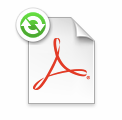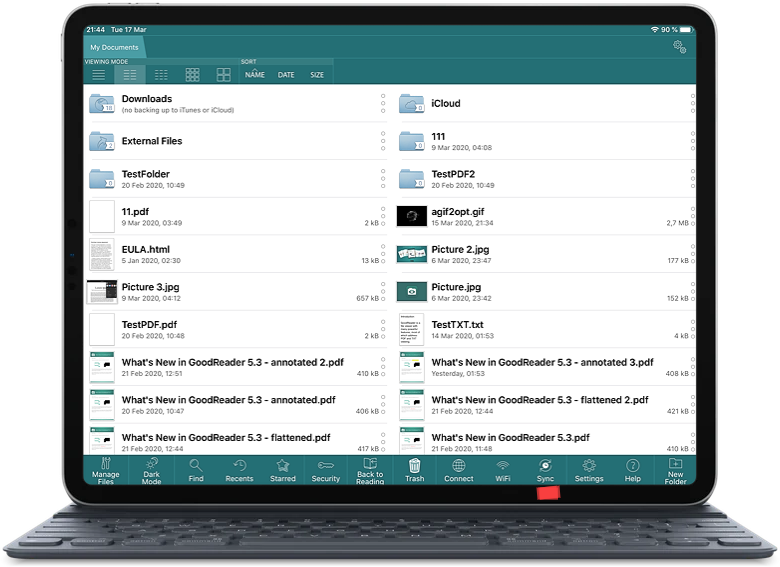GoodReader Networking: Auto Sync

GoodReader can automatically Sync* individual files and entire folders to their remote versions hosted on online servers of the following types: Dropbox, OneDrive, Google Drive, box.com, SugarSync and also any WebDAV, AFP, SMB, FTP or SFTP server.
There are two different types of sync: Normal Sync and Download-Only Sync. The idea of a normal sync is to keep the contents of a local file or folder identical to what you have on the server. The idea of a download-only sync is a convenient distribution of a frequently updated set of documents to a group of people.
The sync process consists of two parts: initial setup and actual synchronization.
Initial setup
Do this only once per each file or folder you wish to synchronize. Open a connection to the server, find the file or folder that you wish to sync, tap it so it becomes highlighted. The Sync button will appear at the bottom. Press it. Then select a target local folder inside GoodReader where you want this file or folder to be put. Then press the Download here & Synchronize button. This will create a synchronization record in the Sync Records section of the Connect panel and show you a setup window where you can set various sync options. Once you`re done with it, you`re ready to sync.
All relevant remote files will be automatically downloaded to your device when doing the very first synchronization, so there is no need to do a manual downloading before the first sync.
All files and folders that are a part of the sync process are tagged with a special badge:

Actual synchronization
You execute a sync by pressing the Sync button on the main screen of the app or on the Connect control panel. (It`s not the same Sync button that you used for the initial setup.) Alternatively, you can find a Sync button at the top of every file viewer`s navigation menu.


This button will execute a sync for all the folders and files with all the servers that you have set up for synchronization. However, if you only want to sync one file or folder, tap Connect, select the Sync Records tab, and use an individual Sync button for each sync record.
A progress popup will appear during a sync. Press the Hide button to hide the popup and continue the sync in the background. You will be able to continue reading your documents while the sync is working. Press the Sync button again to bring back the hidden progress popup. Also, you can press the popup`s Schedule button to set up an automatic periodical sync execution.
Normal sync. During this process GoodReader analyzes the contents of both local and remote folders and does the following:
- Looks for modified files (for example, freshly annotated PDFs) on your device and uploads them to the server, replacing old ones there;
- Looks for modified files on the server and downloads them to your device, replacing the old ones here;
- Looks for new files on the server and downloads them to your device;
- Looks for new local files and uploads them to the server;
- Looks for deleted files on the server that were previously present, and deletes them from your device;
- Looks for deleted local files that were previously present, and deletes them from the server.
Download-only sync. This type of sync doesn`t care what`s happening with your local files. It never puts anything on the server, never deletes anything from it. It only looks for new and modified remote files and downloads them as needed. By default, files that were deleted from the server will be deleted from your local device too. However, you can prevent this from happening by clearing the Delete local files switch in the sync record parameters window. In case if you choose to delete such local files, you can also choose whether or not you want to keep modified local files that were deleted from the server. This option may be useful to preserve your valuable notes that you`ve written on a PDF file, even if the corresponding remote file was deleted from the server.
However, you can prevent this from happening. There are two switches available on a sync record parameters window (accessible via a gear button to the right of a sync record). These switches allow you to prohibit a deletion of local or remote files and folders whose remote or local counterparts are missing at the time of syncing.
If you modify a synced file both locally and on the server independently, and then try syncing it, it will create a Sync Conflict. A sync conflict is an ambiguous situation when GoodReader doesn`t know which version of the file to choose. You can set up a policy on Sync Conflicts per each sync record individually. The following options are available:
- Ask what to do. The default option. You will be able to manually choose an appropriate action per each conflicted file individually during every sync session.
- Leave unresolved. Leaves both files intact, allowing you to deal with this conflict later.
- Local files have priority. Replaces remote conflicted files with local ones, making you lose remote ones forever. Be careful with this option!
- Remote files have priority. Replaces local conflicted files with remote ones, making you lose local ones forever. Be careful with this option!
- Create duplicates. Renames both files to avoid further conflicts, leaving you with both versions of the file everywhere - on your device and on the server. The safest option.
- Also, during a synchronization, GoodReader may sometimes offer you to Discard this conflict, files are identical. This option will only be offered if the files sizes are a match but there is a file modification date inconsistency. Use this option to get rid of the annoying conflict notification, but only if you know for sure that the conflicted files are in fact identical.
While every effort was made to ensure data integrity in all abnormal situations (losing Internet connection, manual process abortion, an app crash, a device shutdown due to low battery, etc.), we strongly encourage you to take precautions to make sure that the sync process is not aborted halfway. Sync process is a sensitive one, and it may result in a data loss if used inappropriately. Just keep that in mind, and everything should be fine.
* Auto Sync is a part of Pro Pack.
Related Questions
V5 is THE killer app
V5 is worth the wait. GoodReader has gone from being just a good file management app to nearly being an OS in its own right.
In addition to viewing, annotating and creating txt and pdf docs, the new drag and drop file management is the missing link in making the iPad a complete solution.
Pencil integration is really really good.
I`m just beginning to dig into the new features and interface, and deciding what other apps I can now delete.
Opening it and finding that V5 had installed was like Christmas morning!
Contact us by e-mail. We're always happy to read your suggestions for improvements and new features, and to answer your questions:
E-mail: support@goodreader.com